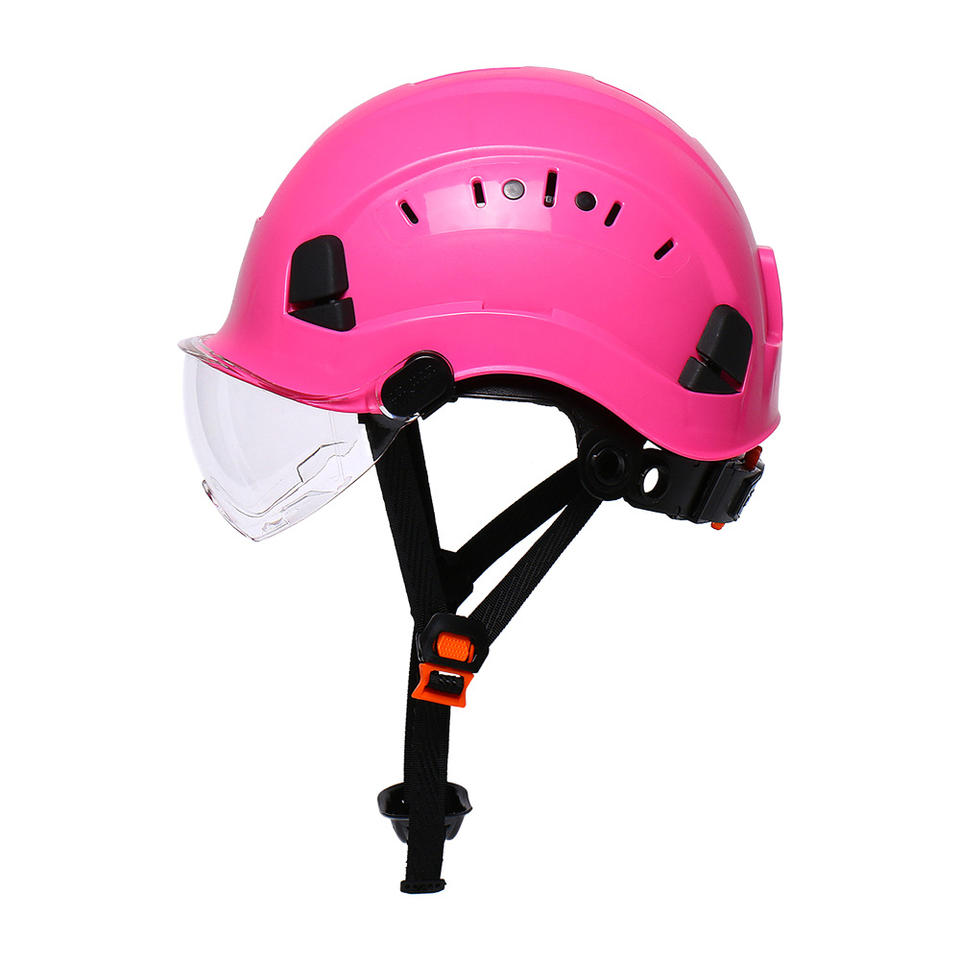Safety Helmet with Visor - Impact-Resistant, Anti-Fog
ABS Material Engineering Safety Helmets with Worker Visor: What Matters in the Real World
If you work around cranes, scaffolds, or just the unpredictable chaos of a busy site, a safety helmet with visor is not “nice to have”; it’s the quiet hero that keeps the day uneventful. I’ve toured more yards than I can count, and the models that stay on workers’ heads (instead of hanging off rebar) are the ones that balance protection with comfort and visibility.

Why the visor is having a moment
Trends first: more contractors are specifying integrated eye/face protection. Actually, it makes sense—integrated visors reduce fogging interfaces, cut procurement complexity, and improve compliance. Many customers say the built-in visor means fewer lost safety glasses and fewer excuses. It seems that visor adoption is rising in construction, utilities, light manufacturing, and even urban maintenance teams where debris and wind are constant.

Product snapshot
| Name | ABS Material Engineering Safety Helmets with Worker Visor |
| Material | ABS shell; visor ≈ polycarbonate, anti-scratch/anti-fog (real-world use may vary) |
| Colors | Red, blue, white, yellow, orange, pink, green, camouflage |
| Size / Fit | Adjustable 52–63 cm; 6-point suspension |
| Weight | ≈700 g |
| Logo | Customized Logo Accepted |
| Supply Ability | ≈5,000 pcs/day |
| Package (single) | 11.81 × 10.24 × 8.66 in |
| Origin | 26 YongPing Road, Northern Industrial Base, Hengshui City, Hebei, China |

How it’s made (quick process flow)
Materials arrive as ABS resin pellets (chosen for impact resistance and dimensional stability). Shells are injection-molded, cooled under controlled conditions, then trimmed. The 6-point suspension—usually HDPE or textile webbing—is assembled and tension-tested. The visor (typically optical-grade polycarbonate) receives anti-scratch and anti-fog coatings, then hinge-mounted. Final QC includes dimensional checks, strap pull tests, and random sample impact/penetration tests per EN397/ANSI Z89.1 protocols. Service life is typically 3–5 years, depending on UV exposure and chemical splash—check the stamp and replace after any serious impact.

Testing, certifications, and data that matter
- Standards referenced: EN 397 (industrial helmets), ANSI/ISEA Z89.1 (Type I/II; Class E/G/C), GB 2811-2019, CSA Z94.1 (as applicable).
- Typical factory test data (sample, indicative): impact force transmission ≈3.8 kN (EN limit ≤5.0 kN); penetration test: 3.0 kg striker at 1.0 m—no contact; dielectric (Class E): leakage
- Certs available on request; always verify batch reports before large deployments.
Where it excels
Construction, working aloft, security protection, mining, general industrial, and utilities. Advantages: integrated protection, fewer loose parts, quick don/doff, and better compliance for teams that “forget” safety glasses. A foreman told me, “Since switching to the safety helmet with visor, our eye incidents dropped and nobody argues about foggy glasses.” To be honest, that’s the kind of metric I like.

Vendor landscape (quick comparison)
| Vendor | Material / Spec | Customization | Lead Time | Certs |
|---|---|---|---|---|
| Goodsafetyhelmet (ABS visor model) | ABS shell; PC visor; 6-point; ≈700 g | Logo, colors, packing | Around 10–20 days (qty-dependent) | EN/ANSI/GB docs on request |
| Generic Importer | ABS or HDPE; mixed visor quality | Limited | ≈15–30 days | Varies; check batch |
| Premium EU Brand | ABS/Blend; high-optics visor | Wide | Stock-dependent | EN/ANSI, extra third-party |
Customization and real-world rollouts
Branding (pad-printed logos), color-coding by trade, and visor tints are common. One utility customer rolled out 2,000 units of the safety helmet with visor with high-visibility yellow shells and clear visors; feedback after three months: better line-of-sight during night shifts and fewer “forgot my glasses” delays. Another contractor went with orange, anti-fog visors, and chinstraps for working aloft—surprisingly, adoption stuck because the fit felt “less wobbly.”

Bottom line: the safety helmet with visor is no gimmick. It tightens your PPE program, simplifies issuance, and—when the coatings are good—keeps visibility crisp in heat or drizzle. Just verify test reports, rotate stock on schedule, and replace after impacts.
Authoritative citations
- EN 397: Industrial safety helmets — European Committee for Standardization (CEN).
- ANSI/ISEA Z89.1: Industrial Head Protection — International Safety Equipment Association.
- GB 2811-2019: Head protection — Standardization Administration of China.
- CSA Z94.1: Industrial protective headwear — Canadian Standards Association.
- EN 166: Personal eye protection — CEN.
-
Essential Guide to Safety Helmets for the Oil and Gas Industry
NewsNov.24,2025
-
Essential Guide to Safety Helmet for Baby – Protect Little Explorers with Confidence
NewsNov.24,2025
-
Comprehensive Guide to Safety Helmet Factory – Global Insights & Innovations
NewsNov.23,2025
-
Rockman Safety Helmet: Ultimate Industrial Head Protection Guide
NewsNov.23,2025
-
Race Safety Helmet – Essential Protection for Motorsport Champions
NewsNov.22,2025
-
Offshore Safety Helmet Guide: Protecting Workers in Harsh Marine Environments
NewsNov.22,2025
